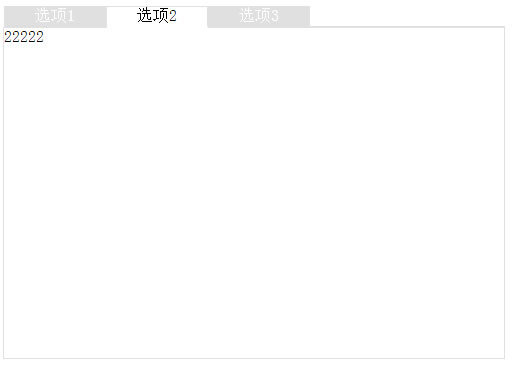
Das Beispiel in diesem Artikel beschreibt die Entwicklungsmethode für jQuery-Komponenten und wird allen als Referenz zur Verfügung gestellt. Die Details lauten wie folgt:
Das vorherige „JavaScript-Komponentenentwicklung“ analysierte die Techniken der JavaScript-Komponentenentwicklung. Hier analysieren wir die Methode der Verwendung von jQuery für die Komponentenentwicklung.
Die Prinzipien der Verwendung von jQuery für die Komponentenentwicklung ähneln grundsätzlich der Verwendung reiner JavaScript-Skripte (ohne Verwendung eines Frameworks), insbesondere ist die Organisation öffentlicher Methoden dieselbe.
Der Unterschied besteht darin, dass jQuery einen Plug-in-Mechanismus verwendet, um das Operationsobjekt (DOM-Element) direkt über $() zu binden und dann Ereignisse an das DOM-Element oder den HTML-Code zu binden.
Ein weiterer Unterschied besteht darin, dass jQuery als Werkzeug zum Erstellen von DOM-Objekten, zur schnellen Suche nach bestimmten DOM-Objekten usw. verwendet wird.
Beispieltest bestanden.
Ein einfaches Grundbeispiel, das nur die Funktionen zum Hinzufügen von Seiten und Auswählen von Seiten implementiert.
<!DOCTYPE html PUBLIC "-//W3C//DTD XHTML 1.0 Transitional//EN"
"http://www.w3.org/TR/xhtml1/DTD/xhtml1-transitional.dtd">
<html xmlns="http://www.w3.org/1999/xhtml">
<head>
<title> Design JS component with jQuery </title>
<script src="jquery.js" type="text/javascript"></script>
<link href="tabs.css" rel="stylesheet" type="text/css" />
<style>
.tabsDiv{width: 500px;height: 350px;margin-top: 0px;margin-left: 0px;}
.tabsDiv ul{
width: 500px;height: 20px;
list-style: none;
margin-bottom: 0px;margin: 0px;
padding: 0px;
border-left:solid 1px #ffffff;border-right:solid 1px #ffffff;border-top:solid 1px #ffffff;border-bottom:solid 1px #e0e0e0;
}
.tabsDiv div{
width: 500px;height: 330px;
background-color: #ffffff;
border:solid 1px #e0e0e0;
}
.tabsSeletedLi{
width: 100px;height: 20px;
background-color: white;
float: left;
text-align: center;
border-left:solid 1px #e0e0e0;border-right:solid 1px #e0e0e0;border-top:solid 1px #e0e0e0;border-bottom:solid 1px #ffffff;
}
.tabsSeletedLi a{
width: 100px;
height: 20px;
color:#000000;
text-decoration:none;
}
.tabsUnSeletedLi{
width: 100px;height: 20px;
background-color: #e0e0e0;
float: left;
text-align: center;
border:solid 1px #e0e0e0;
}
.tabsUnSeletedLi a{
width: 100px;height: 20px;
color: #ffffff;
text-decoration:none;
}
</style>
</head>
<body>
<!--
<div style="width:400px;height:100px;border:solid 1px #e0e0e0;">
</div>
-->
<!--tabs示例-->
<div id="mytabs">
<!--选项卡区域-->
<ul>
<li><a href="#tabs1">选项1</a></li>
<li><a href="#tabs2">选项2</a></li>
<li><a href="#tabs3">选项3</a></li>
</ul>
<!--面板区域-->
<div id="tabs1">11111</div>
<div id="tabs2">22222</div>
<div id="tabs3">33333</div>
</div>
<script lang="javascript">
(function ($) {
$.fn.tabs = function (options) {
var me = this;
//使用鼠标移动触发,亦可通过click方式触发页面切换
var defualts = { switchingMode: "mousemove" };
//融合配置项
var opts = $.extend({}, defualts, options);
//DOM容器对象,类似MX框架中的$e
var $e = $(this);
//选中的TAB页索引
var selectedIndex = 0;
//TAB列表
var $lis;
//PAGE容器
var aPages = [];
//初始化方法
me.init = function(){
//给容器设置样式类
$e.addClass("tabsDiv");
$lis = $("ul li", $e);
//设置TAB头的选中和非选中样式
$lis.each(function(i, dom){
if(i==0){
$(this).addClass("tabsSeletedLi")
}else{
$(this).addClass("tabsUnSeletedLi");
}
});
//$("ul li:first", $e).addClass("tabsSeletedLi");
//$("ul li", $e).not(":first").addClass("tabsUnSeletedLi");
//$("div", $e).not(":first").hide();
//TAB pages绑定
var $pages = $('div', $e);
$pages.each(function(i, dom){
if(i == 0){
$(this).show();
}else{
$(this).hide();
}
aPages.push($(this));
});
//绑定事件
$lis.bind(opts.switchingMode, function() {
var idx = $lis.index($(this))
me.selectPage(idx);
});
}
/**
* 选中TAB页
*
*/
me.selectPage = function(idx){
if (selectedIndex != idx) {
$lis.eq(selectedIndex).removeClass("tabsSeletedLi").addClass("tabsUnSeletedLi");
$lis.eq(idx).removeClass("tabsUnSeletedLi").addClass("tabsSeletedLi");
aPages[selectedIndex].hide();
aPages[idx].show();
selectedIndex = idx;
};
}
me.showMsg = function(){
alert('WAHAHA!');
}
//自动执行初始化函数
me.init();
//返回函数对象
return this;
};
})(jQuery);
</script>
<script type="text/javascript">
/*
$(function () {
$("#mytabs").tabs;
});
*/
var tab1 = $("#mytabs").tabs();
tab1.showMsg();
</script>
</body>
</html>
Der Endeffekt ist wie im Bild gezeigt:

Ich hoffe, dass dieser Artikel allen in der jQuery-Programmierung hilfreich sein wird.
 Was sind die JQuery-Plug-Ins?
Was sind die JQuery-Plug-Ins?
 So bedienen Sie JSON mit JQuery
So bedienen Sie JSON mit JQuery
 So löschen Sie Elemente in JQuery
So löschen Sie Elemente in JQuery
 Verwendung der jQuery-Methode hover()
Verwendung der jQuery-Methode hover()
 jquery implementiert die Paging-Methode
jquery implementiert die Paging-Methode
 Was ist ein verstecktes Element in jquery?
Was ist ein verstecktes Element in jquery?
 Was wird in jquery hervorgehoben?
Was wird in jquery hervorgehoben?
 Tutorial zum Ausführen von C++-Code
Tutorial zum Ausführen von C++-Code
 Was tun, wenn der Bluetooth-Schalter in Windows 10 fehlt?
Was tun, wenn der Bluetooth-Schalter in Windows 10 fehlt?




